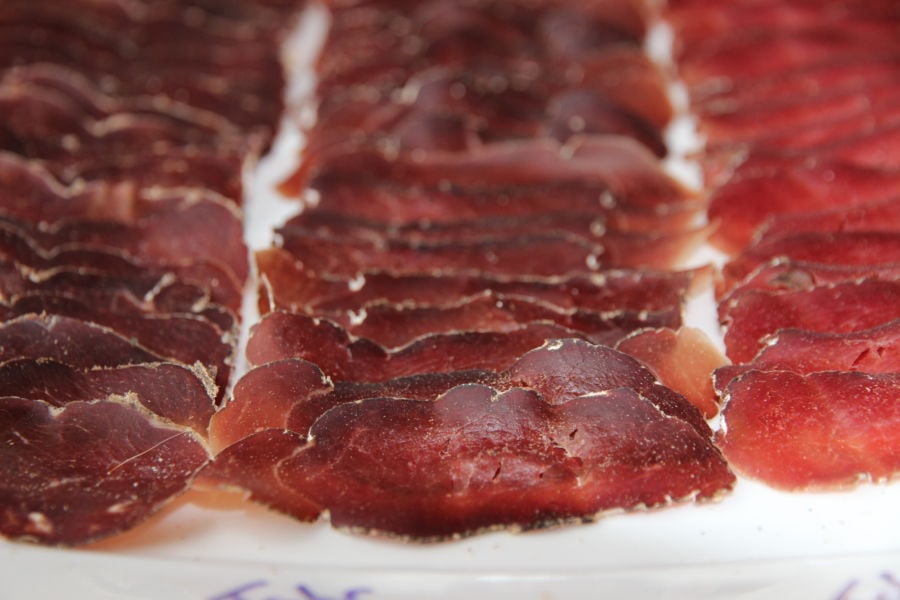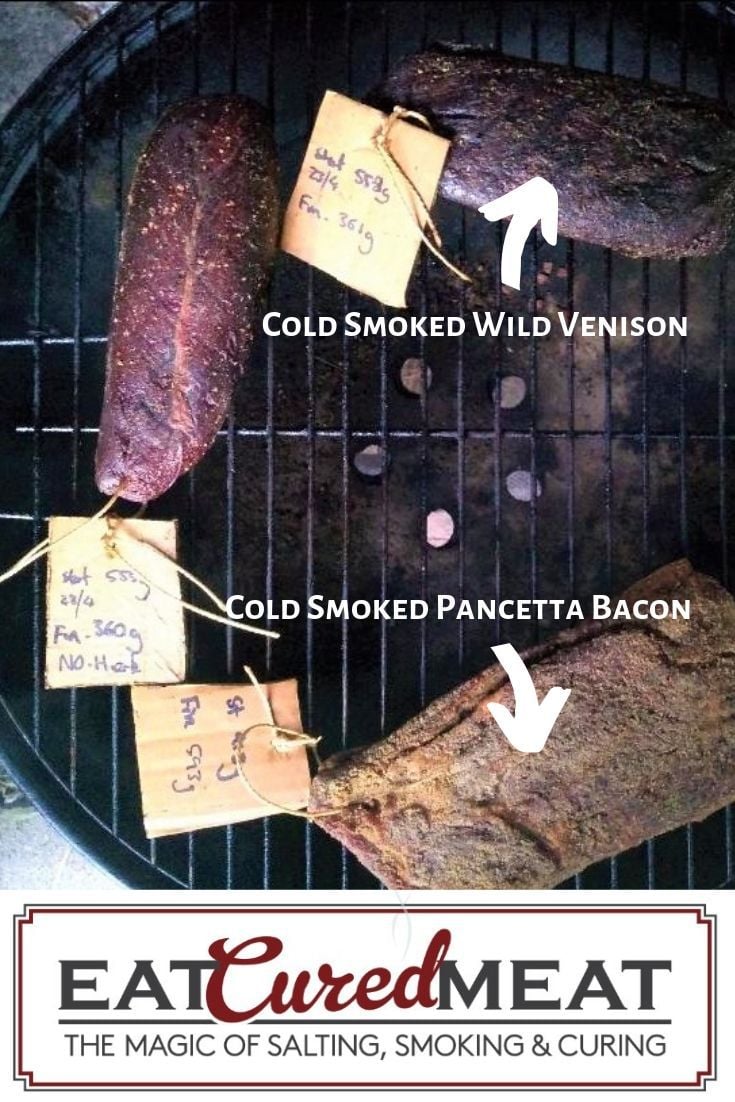Pink curing salt, also known as Prague powder, has become an essential ingredient in many of my cured meat projects — from bacon and pastrami to pancetta and bresaola. It’s a precise tool that helps me create consistent results and achieve that distinctive color and flavor associated with traditional cured meats.
Over the last couple of decades, I’ve experimented with and studied curing salts in detail. This article explains what pink curing salt actually is, the difference between No. 1 and No. 2, and how I use it safely and accurately at home.
If you’re new to curing, this overview will help you understand when to use it, how much to use, and why it matters in both short- and long-term cures.
Summary Points
- Pink curing salt is used in meats like bacon, ham, and pastrami to control bacteria and develop the classic cured color.
- There are two types — #1 (for short cures under 30 days) and #2 (for long-term dry curing).
- It contains measured amounts of sodium nitrite and/or nitrate blended with salt to prevent spoilage and create stable, safe products.
- Equilibrium curing uses precise salt percentages based on the total meat weight to ensure even flavor and safety.
- Different countries use similar curing mixes with slightly different nitrite and nitrate ratios.
- Using pink curing salt is optional — some traditional dry cures can be made without it, depending on the style and duration.
I’ve used pink curing salt in hundreds of small and large curing projects over the years. Whether I’m working with a wild venison leg, a pork belly for bacon, or whole-muscle pancetta, I always calculate the curing salt as part of the total salt percentage. Precision is everything when it comes to both safety and taste.

What Is Pink Curing Salt?
Pink curing salt is a standardized mixture of common salt and small, carefully measured amounts of sodium nitrite (#1) or a blend of sodium nitrite and sodium nitrate (#2). The pink color is simply a food-safe dye that distinguishes it from table salt to prevent accidental misuse. Despite the name, it isn’t related to Himalayan salt — the pink dye is just a safety marker.
Two versions exist for different curing timelines. Pink Curing Salt #1 is designed for shorter cures or meats that will be cooked afterward. Pink Curing Salt #2 is used for long-term dry cures such as salami, prosciutto, or bresaola, where the meat will air-dry over many weeks or months.
| Type | Salt (%) | Sodium Nitrite (%) | Sodium Nitrate (%) | Typical Use |
| Pink Curing Salt #1 | 93.75 | 6.25 | – | Short cures (< 30 days), cooked products like bacon, corned beef or pastrami |
| Pink Curing Salt #2 | 89.75 | 6.25 | 4.00 | Long cures (> 30 days), air-dried meats like salami, bresaola, pancetta or coppa |
The small percentage of nitrite or nitrate in these salts works within the meat to slow microbial growth and stabilize its color. During longer cures, nitrate gradually converts into nitrite, extending its protective effect as the meat loses moisture over time.
Why Meat Turns Pink When Cured
The pink hue in cured meats is caused by a natural chemical reaction between the sodium nitrite in the curing mix and the myoglobin in the meat. When nitrite interacts with myoglobin, it forms a stable compound called nitrosomyoglobin, which keeps the meat pink even after cooking. That’s why cured bacon and hams stay rosy instead of turning grey like roasted pork.
If I skip nitrites or nitrates entirely in a homemade cure, the color remains duller and more natural — which is fine for some traditional styles but visually different. Both approaches have their place, depending on the curing goal and how long the meat will be stored.
Do You Have to Use Pink Curing Salt?
For many home curing projects, pink curing salt is a choice rather than a rule. It’s most beneficial when you’re working with sealed or low-oxygen environments, such as vacuum-packed cures, or when meat will cure for weeks before drying or smoking. In these conditions, nitrite helps control unwanted bacteria and ensures a more consistent result.
However, some traditional dry cures that rely purely on sea salt, airflow, and lower moisture can be done safely without pink curing salt when handled correctly. The decision comes down to the specific technique, curing duration, and personal preference. Throughout this guide, I’ll show how I measure and use it for accuracy rather than treating it as mandatory.
How I Use Pink Curing Salt Accurately
Once you understand which curing salt to use, accuracy becomes the most important part. Whether I’m dry-curing or brining, I always weigh the curing ingredients to the gram. Measuring by weight keeps every batch consistent and prevents mistakes that could affect texture, flavor, or safety.
The classic commercial recommendation is “4 ounces per 100 pounds of meat,” which equals roughly 0.25%. At home, I apply the same percentage by using digital scales that measure to 0.01 grams. For example, when curing 1 kilogram (1000 grams) of meat, 0.25% equals 2.5 grams of pink curing salt #1 or #2 added to 27.5 grams of sea salt — a total of 3% salt overall.

Equilibrium Curing Method
Equilibrium curing is the modern way to reach precise salinity and curing-salt levels without guesswork. The salt percentage is based on the meat’s total weight rather than a fixed recipe amount, ensuring the same flavor and safety every time. You can quickly calculate the exact ratio using my equilibrium curing calculator, which automatically includes the standard 0.25% pink curing salt in its math.
This approach also avoids the problem of over-salting that used to happen with older “soak-and-check” brine cures. Once the cure reaches balance, the meat neither gains nor loses salt unevenly; it simply stabilizes at the intended concentration.
Dry Cure vs Brine Cure
There are two main ways I apply curing salts — a dry cure or a wet brine. Both work, but the calculations differ.
- Dry Cure Method – The salt and curing mix are rubbed directly onto the meat surface. I prefer this for whole-muscle projects such as bresaola or coppa, where even distribution and moisture loss are key.
- Brine Method – Curing salt dissolves in water to make a brine, sometimes called wet-brining or pickling. The usual guide is 1 teaspoon per 5 pounds of meat, but I still weigh everything for consistency.
I’ve found equilibrium brining especially useful for large cuts like hams or pastrami. By sealing the brine and meat in a food-grade container or bag, the cure equalizes slowly until the percentages match exactly — producing firm texture and balanced seasoning without excessive saltiness.
Why Accurate Scales Matter
Because pink curing salt is potent, small errors matter. A kitchen scale that reads precisely to 0.1 grams or better is ideal. Inaccurate teaspoons or rounded estimates can easily double the nitrite level, which changes color development and may produce harsh, overly cured flavor. Professional meat curers and hobbyists alike rely on laboratory-style scales for this reason.
Safety, Regulations, and Nitrite Facts
The correct use of curing salt is well-studied and guided by food-safety authorities. According to the USDA curing guidelines, the 6.25% nitrite concentration in pink curing salt #1 has been standardized to prevent both under- and over-curing. It’s designed to be safe when used at 0.25% of the meat weight.
New Zealand’s Food Standards Authority and the European Food Safety Authority (EFSA) both support similar limits for sodium nitrite and nitrate in processed meats. These levels are set far below toxic thresholds and are continually reviewed through toxicological and epidemiological data.
For a clear technical explanation, the American Meat Science Association describes how nitrite not only prevents botulism in low-oxygen environments but also stabilizes flavor and delays oxidation. This aligns with what I’ve seen in practice — meats cured with the right ratio hold color longer and taste cleaner after months of drying.
Nitrite, Nitrate, and Human Diet Context
Nitrites and nitrates aren’t unique to cured meats; they naturally occur in vegetables and even drinking water. According to peer-reviewed research on dietary nitrates and nitrites from vegetables, about 80–90% of our average nitrate intake actually comes from greens like spinach and beetroot, not from cured meat. Within the body, nitrates can convert to nitric oxide, a compound involved in blood-flow regulation.
Popular science outlets such as Healthline’s medically reviewed summary of nitrates and nitrites in food explain this balance well: the health impact depends on dose, cooking temperature, and accompanying antioxidants like vitamin C. When curing meats, nitrite levels are extremely low and tightly controlled.
To reduce risk of nitrosamine formation, cured meats shouldn’t be exposed to very high dry-frying temperatures. Studies and the textbook Home Production of Quality Meats and Sausages note that carcinogenic nitrosamines form mainly above 130 °C (266 °F). Typical air-drying, cold smoking, or gentle cooking temperatures stay well below that range.
Why I Still Choose to Use It
While pink curing salt is optional for some rustic styles, I use it for most equilibrium cures because it gives me predictable results. It stabilizes the meat, lets me control salt levels precisely, and preserves that traditional rosy color. Used in the right ratio, it’s simply a proven safety and quality tool — not a shortcut or artificial additive.
For anyone learning to cure meat at home, I recommend reading widely. My recommended meat-curing books include in-depth discussions by master curers who explain both modern and traditional perspectives on nitrite use.
Together with careful temperature and humidity control, accurate measurement and patience are what keep cured meat safe, delicious, and authentic — just as generations of artisans have done, now backed by modern science.
Precautions When Using Pink Curing Salt
Because pink curing salt is powerful in very small quantities, it’s essential to measure precisely and follow established guidelines. I never estimate or round when using it. Every gram matters. Double-checking each calculation avoids uneven coloring or excessive curing levels.
The book Salumi by Ruhlman & Polcyn explains that nitrates and nitrites are not foreign chemicals added to food but natural compounds our bodies encounter every day. Leafy greens and root vegetables contribute far more dietary nitrates than cured meats ever will. In a balanced curing environment, these compounds simply prevent the growth of dangerous bacteria such as Clostridium botulinum.
When I make small home batches, the amount of curing salt used can be less than half a teaspoon for several kilograms of meat. Once mixed evenly with the rest of the salt and sugar, it becomes completely dispersed throughout the cure. I label all curing mixes clearly and store them away from common table salt to prevent confusion.
It’s worth remembering that pink curing salt is not interchangeable with Himalayan pink salt or regular sea salt. The color only indicates it’s dyed for identification. Substituting or confusing the two can completely change the curing chemistry.
If the incorrect amount is used, results may vary from patchy color to overly salty or metallic-tasting meat. That’s why I rely on equilibrium curing: once the right ratio is sealed in, it simply can’t over-cure. The meat absorbs exactly the amount needed and stabilizes at equilibrium.
Over the years, I’ve left vacuum-packed meats curing in the fridge for months. When opened, the meat color and texture were consistent, showing how stable equilibrium curing can be when the salt percentage and time are correct.
Temperature and Cooking Safety
Cured meats should never be fried or grilled at extreme heat. Scientific research and the textbook Home Production of Quality Meats and Sausages note that nitrosamines—unwanted by-products—form mainly when products exceed 130 °C (266 °F). Air-drying, cold-smoking, and gentle cooking all stay far below this level. That’s another reason traditional methods remain safe when properly controlled.
Different Names and International Variations
Pink curing salt is sold under many names, but they all follow the same basic ratios. Recognizing the label helps ensure you’re using the correct type for your project.
| Under 30 Days (#1) | Over 30 Days (#2) |
| Prague Powder #1 | Prague Powder #2 |
| Instacure #1 | Instacure #2 |
| Tinted Curing Mix (TCM) #1 | Tinted Curing Mix (TCM) #2 |
| Quick Cure #1 | Quick Cure #2 |
In Europe, curing salts sometimes follow different legal limits. Brands such as Sel Nitrite (France), Peklosol (Poland), and Nitrited Salt (UK) contain lower nitrite concentrations—typically 0.6 % instead of 6.25 %. Because of that difference, my equilibrium curing calculator isn’t suitable for those versions, and local labeling should always be checked carefully.
Other commercial blends like Morton Tender Quick include sugar and sometimes small phosphate additions. They can produce good results but require following each manufacturer’s instructions precisely, since their nitrite levels differ from the standard pink curing salts.
Useful References and Further Reading
For a deeper technical look at nitrite chemistry, the American Meat Science Association provides detailed resources. Regulatory information is also published by the European Food Safety Authority and the USDA curing guidelines. Together these confirm that when used at approved ratios, curing salts remain one of the most reliable and well-understood preservation tools in food production.
Frequently Asked Questions About Pink Curing Salt
Is pink curing salt safe to use at home?
Yes. When measured accurately at 0.25 % of meat weight (4 oz per 100 lb), pink curing salt is considered safe by the USDA and EFSA. Always weigh it precisely and mix thoroughly with regular salt.
What is the difference between pink curing salt #1 and #2?
#1 contains salt and sodium nitrite for short-term cures (under 30 days). #2 adds a small amount of sodium nitrate that slowly converts to nitrite for long air-dried cures.
Can I substitute Himalayan or table salt for pink curing salt?
No. Himalayan and table salt lack nitrite and nitrate. They will not protect against botulism in long cures and should never replace curing salt.
Do nitrates make cured meat unhealthy?
Current scientific consensus shows that nitrite levels in properly cured meats are very low and similar to those found naturally in vegetables. Avoid overheating (>130 °C / 266 °F) to minimize nitrosamine formation.
Have a question about pink curing salt or equilibrium curing? Share it below — I’m always happy to discuss methods, ratios, or traditional styles that have worked for you.

Tom Mueller
For decades, immersed in studying, working, learning, and teaching the craft of meat curing, sharing the passion and showcasing the world of charcuterie and smoked meat. Read More
